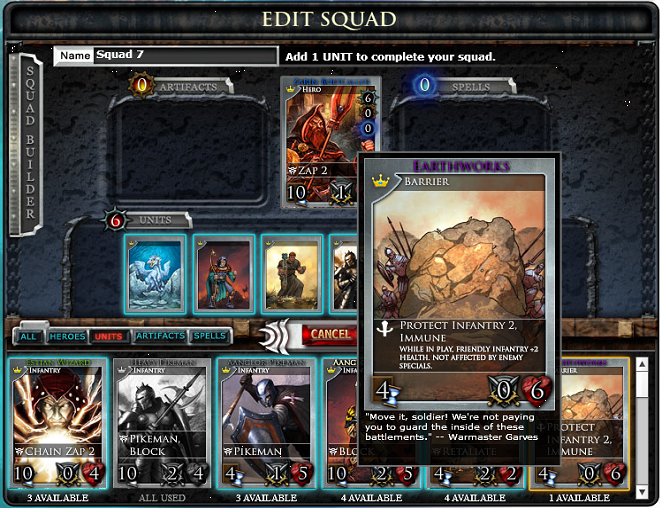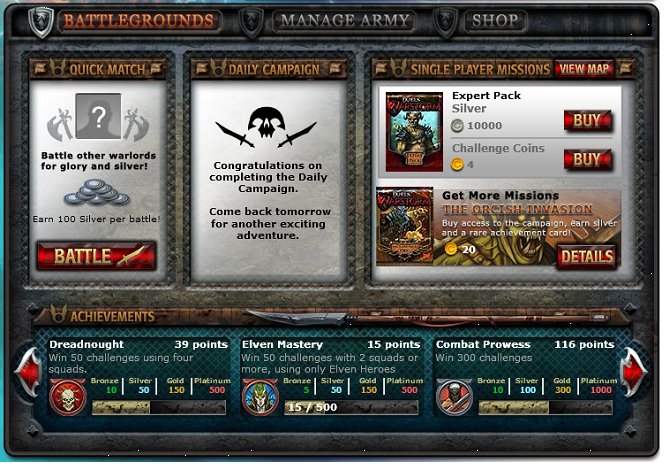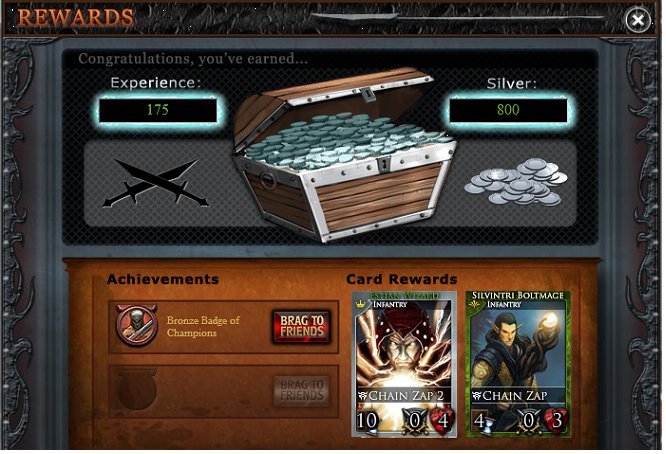Experimental Game Dev Podcast Show
Experimental Game Dev Interviews — The First Game Dev Podcast Ever-
Designing Mobile Games for the iPhone and Blackberry
Posted on December 30th, 2009 No commentsJoshua with WarpTheForm talks about developing iPhone and Blackberry games
You can download the podcast here…
http://www.indiegamepod.com/podcasts/agdc-warp-the-form-interview-podcast.mp3Or listen to it here…
-
Using the Versant Database To Scale Your MMO
Posted on December 27th, 2009 No commentsDavid, from Versant, talks about scaling your MMO
You can download the podcast here…
http://www.indiegamepod.com/podcasts/agdc-versant-interview.mp3Or listen to it here…
[wp_youtube]DVQLWxbtBl0[/wp_youtube]
-
Game Design Review: WarStorm
Posted on December 25th, 2009 2 commentsHey folks,
This show is dedicated to experimental games. With that said, we’re introducing a new feature. We’re going to have game design reviews of various games. We’ll focus on the game mechanics behind the games. For now, we’ll cover games on some of the new platforms … like social games, iPhone games, and alternate reality games.
Each review will focus on the game mechanics that make the game fun…as well as potential new mechanics that would enhance the experience. Feel free to post feedback.
Game Name: WarStorm
Game Link: http://www.facebook.com/apps/application.php?id=29507308663
Overview: In Warstorm: Challenges the player collects cards representing troops in a vast army. He builds decks in 7-card segments called “squads,” and then pits one to four squads against the computer or other players. There is a campaign mode, an arena, and a “daily campaign,” which is a new feature for the Facebook version of the game.
Collection: Warstorm: Challenges has this mechanic in spades. There are literally hundreds of cards to collect, and a player can theoretically include as many as 36 copies of one card in his deck. With certain card combinations that produce massive results in the game, there is a strong impetus to keep collecting more and more cards.
Purchased Collecting: The player can buy “novice” cards fairly cheaply, or the more advanced “expert” cards for a higher price. Playing against another player in their arena mode earns you points whether you win or lose, so the collection mechanic feeds back in and directly encourages the player to keep playing.
No Choices: For all the options the player has when putting together a deck, there is no decision-making once the battle begins. The game runs a simulation for how the decks clash and determines a winner. The positive side of this is that the more casual player doesn’t feel pressured to sit in place for half an hour while an opponent decides on moves in real-time. The negative side is that players often feel that they aren’t really playing the game (I’ve surveyed friends who tried this out, and it’s a frequent complaint in the forums).

Achievement: In the previous iteration of the game, on a separate site, Warstorm did very well by having a nice large achievement section for the player to reference. In the Facebook version they’ve improved on that design by placing the achievements you’re closest to achieving front and center on your main page. When I ran out of campaigns to overcome in the old edition, achievements are what kept me playing for a few more weeks.
Updated Content: This version does an even better job of providing a compelling play experience by including the “daily campaign.” Essentially, each day there is a new specific deck to defeat. Because the core of “gameplay” in Warstorm: Challenges is the building of the deck (this is where the player can make strategic decisions that affect his outcome), the inclusion of set decks to defeat makes Warstorm an actual game, not just a collection mechanic attached to a card game simulation.
Art: The art is middling. The card art loses a lot of its punch on the new smaller size Facebook permits, and the new interface additions make things feel a little crowded. On the other hand, every individual piece of art is quite decent and supports the general swords and sorcery theme.
Story: Not integrated enough. I’m a player whose primary interest is often in storyline, and I skip past the text that tells the story of why I’m having this or that battle, because I just don’t care and it never impacts gameplay. When I do read it, the writing is so-so; decent but unmemorable.

Well-Implemented Notification: When you gain an achievement in Warstorm, you get a button on the mission briefing entitled “brag to friends.” Because it’s built into the system it’s less obtrusive than the usual pop-up, and the tiny shift in wording makes it surprisingly enticing.
Player-Generated Content: This is the big thing missing, in my opinion. The players should be able to challenge one another with “towers” or some similar structure, with one player making a deck and others trying to beat it as the day wears on. This would allow the game (that is, the part where you’re designing a deck) to remain interesting for, essentially, an infinite amount of time. The reward structure would be difficult to devise, but it would take the game experience to the next level, even for the social or casual gamer.
Overview: In Warstorm: Challenges the player collects cards representing troops in a vast army. He builds decks in 7-card segments called “squads,” and then pits one to four squads against the computer or other players. There is a campaign mode, an arena, and a “daily campaign,” which is a new feature for the Facebook version of the game.

Collection: Warstorm: Challenges has this mechanic in spades. There are literally hundreds of cards to collect, and a player can theoretically include as many as 36 copies of one card in his deck. With certain card combinations that produce massive results in the game, there is a strong impetus to keep collecting more and more cards.Purchased Collecting: The player can buy “novice” cards fairly cheaply, or the more advanced “expert” cards for a higher price. Playing against another player in their arena mode earns you points whether you win or lose, so the collection mechanic feeds back in and directly encourages the player to keep playing.
No Choices: For all the options the player has when putting together a deck, there is no decision-making once the battle begins. The game runs a simulation for how the decks clash and determines a winner. The positive side of this is that the more casual player doesn’t feel pressured to sit in place for half an hour while an opponent decides on moves in real-time. The negative side is that players often feel that they aren’t really playing the game (I’ve surveyed friends who tried this out, and it’s a frequent complaint in the forums).
Achievement: In the previous iteration of the game, on a separate site, Warstorm did very well by having a nice large achievement section for the player to reference. In the Facebook version they’ve improved on that design by placing the achievements you’re closest to achieving front and center on your main page. When I ran out of campaigns to overcome in the old edition, achievements are what kept me playing for a few more weeks.

Updated Content: This version does an even better job of providing a compelling play experience by including the “daily campaign.” Essentially, each day there is a new specific deck to defeat. Because the core of “gameplay” in Warstorm: Challenges is the building of the deck (this is where the player can make strategic decisions that affect his outcome), the inclusion of set decks to defeat makes Warstorm an actual game, not just a collection mechanic attached to a card game simulation.
Art: The art is middling. The card art loses a lot of its punch on the new smaller size Facebook permits, and the new interface additions make things feel a little crowded. On the other hand, every individual piece of art is quite decent and supports the general swords and sorcery theme.
Story: Not integrated enough. I’m a player whose primary interest is often in storyline, and I skip past the text that tells the story of why I’m having this or that battle, because I just don’t care and it never impacts gameplay. When I do read it, the writing is so-so; decent but unmemorable.

Well-Implemented Notification: When you gain an achievement in Warstorm, you get a button on the mission briefing entitled “brag to friends.” Because it’s built into the system it’s less obtrusive than the usual pop-up, and the tiny shift in wording makes it surprisingly enticing.Player-Generated Content: This is the big thing missing, in my opinion. The players should be able to challenge one another with “towers” or some similar structure, with one player making a deck and others trying to beat it as the day wears on. This would allow the game (that is, the part where you’re designing a deck) to remain interesting for, essentially, an infinite amount of time. The reward structure would be difficult to devise, but it would take the game experience to the next level, even for the social or casual gamer.
-
Using Surfpin For Mobile Payments
Posted on December 24th, 2009 No commentsNicholas with Surfpin talks about their mobile payments program
You can download the podcast here…
http://www.indiegamepod.com/podcasts/agdc-surfpin-interview.mp3Or listen to it here…
-
Developing Indie iPhone Games
Posted on December 21st, 2009 No commentsMiguel, from Stratogon, discusses iPhone game development
You can download the podcast here…
http://www.indiegamepod.com/podcasts/agdc-strategon-interview-podcast.mp3Or listen to it here…
[wp_youtube]_FHr6_vRgCc[/wp_youtube]
-
The Benefits Of The +7 balance engine
Posted on December 18th, 2009 No commentsNathaniel, from +7 Systems, talks about their tool for developers
You can download the podcast here…
http://www.indiegamepod.com/podcasts/agdc-seven-systems.mp3Or listen to it here…
-
The Tales of an Indie iPhone Game Studio
Posted on December 15th, 2009 No commentsDelano, from Resolute Games, discusses iPhone games and iPhone apps
You can download the podcast here…
http://www.indiegamepod.com/podcasts/agdc-resolute-games-interview.mp3Or listen to it here…
[wp_youtube]PMs3tdOWb1I[/wp_youtube]
-
Designing and Running an Online Board Game
Posted on December 12th, 2009 No commentsJimmi discusses his game, Quadradius
You can download the podcast here…
http://www.indiegamepod.com/podcasts/agdc-quadradius-interview.mp3Or listen to it here…
[wp_youtube]bMAr3J6kqsU[/wp_youtube]
-
Developing an Indie Casual Puzzle Game
Posted on December 9th, 2009 1 commentMichael, from Ludoko, talks about Paranormal Puzzle Society
You can download the podcast here…
http://www.indiegamepod.com/podcasts/agdc-paranormal-puzzle-society-interview-podcast.mp3Or listen to it here…
-
Using MPlayit to Market Your iPhone Game
Posted on December 6th, 2009 No commentsMichael, from Mplayit.com, talks about their iPhone Arcade on Facebook
You can download the podcast here…
http://www.indiegamepod.com/podcasts/agdc-mplayer-interview-podcast.mp3Or listen to it here…

